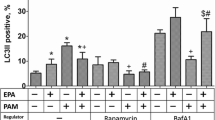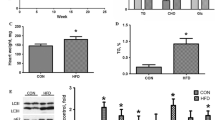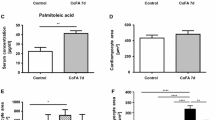Abstract
Elevated circulatory free fatty acids (FFAs) especially saturated FFAs, such as palmitate (PA), are detrimental to the heart. However, mechanisms responsible for this phenomenon remain unknown. Here, the role of JAK2/STAT3 in PA-induced cytotoxicity was investigated in cardiomyocytes. We demonstrate that PA suppressed the JAK2/STAT3 pathway by dephosphorylation of JAK2 (Y1007/1008) and STAT3 (Y705), and thus blocked the translocation of STAT3 into the nucleus. Conversely, phosphorylation of S727, another phosphorylated site of STAT3, was increased in response to PA treatment. Pretreatment of JNK inhibitor, but not p38 MAPK inhibitor, inhibited STAT3 (S727) activation induced by PA and rescued the phosphorylation of STAT3 (Y705). The data suggested that JNK may be another upstream factor regulating STAT3, and verified the important function of P-STAT3 (Y705) in PA-induced cardiomyocyte apoptosis. Sodium orthovanadate (SOV), a protein tyrosine phosphatase inhibitor, obviously inhibited PA-induced apoptosis by restoring JAK2/STAT3 pathways. This effect was diminished by STAT3 inhibitor Stattic. Collectively, our data suggested a novel mechanism that the inhibition of JAK2/STAT3 activation was responsible for palmitic lipotoxicity and SOV may act as a potential therapeutic agent by targeting JAK2/STAT3 in lipotoxic cardiomyopathy treatment.







Similar content being viewed by others
Abbreviations
- PA:
-
Palmitate
- FFAs:
-
Free fatty acids
- BSA:
-
Bovine serum albumin
- JAK:
-
Janus kinase
- STAT3:
-
Signal transducer and activator of transcription 3
- SOV:
-
Sodium orthovanadate
- PTP:
-
Protein tyrosine phosphatase
- PBS:
-
Phosphate buffered saline
- NRVM:
-
Neonatal rat ventricular myocytes
- ROS:
-
Reactive oxygen species
References
Trivedi PS, Barouch LA (2008) Cardiomyocyte apoptosis in animal models of obesity. Curr Hypertens Rep 10(6):454–460
Szczepaniak L, Victor R, Orci L, Unger R (2007) Forgotten but not gone: the rediscovery of fatty heart, the most common unrecognized disease in America. Circ Res 101(8):759–767
Wencker D, Chandra M, Nguyen K, Miao WF, Garantziotis S, Factor SM, Shirani J, Armstrong RC, Kitsis RN (2003) A mechanistic role for cardiac myocyte apoptosis in heart failure. J Clin Invest 111(10):1497–1504
Dyntar D, Eppenberger-Eberhardt M, Maedler K, Pruschy M, Eppenberger HM, Spinas GA, Donath MY (2001) Glucose and palmitic acid induce degeneration of myofibrils and modulate apoptosis in rat adult cardiomyocytes. Diabetes 50(9):2105–2113
Sparagna GC, Hickson-Bick DL, Buja LM, McMillin JB (2000) A metabolic role for mitochondria in palmitate-induced cardiac myocyte apoptosis. Am J Physiol Heart Circ Physiol 279(5):H2124–H2132
Lopaschuk GD, Ussher JR, Folmes CDL, Jaswal JS, Stanley WC (2010) Myocardial fatty acid metabolism in health and disease. Physiol Rev 90(1):207–258
Liu J, Chang F, Li F, Fu H, Wang JL, Zhang SL, Zhao J, Yin DL (2015) Palmitate promotes autophagy and apoptosis through ROS-dependent JNK and p38 MAPK. Biochem Biophys Res Common 463(3):262–267
Du WJ, Pan ZW, Chen X, Wang LM, Zhang Y, Li S, Liang HH, Xu CQ, Zhang Y, Wu YP, Shan HL, Lu YJ (2014) By targeting stat3 microRNA-17-5p promotes cardiomyocyte apoptosis in response to ischemia followed by reperfusion. Cell Physiol Biochem 34(3):955–965
Negoro S, Kunisada K, Fujio Y, Funamoto M, Darville MI, Eizirik DL, Osugi T, Izumi M, Oshima Y, Nakaoka Y, Hirota H, Kishimoto T, Yamauchi-Takihara K (2001) Activation of signal transducer and activator of transcription 3 protects cardiomyocytes from hypoxia/reoxygenation-induced oxidative stress through the upregulation of manganese superoxide dismutase. Circulation 104(9):979–981
Wang G, Wang JJ, Chen XL, Du SM, Li DS, Pei ZJ, Lan H, Wu LB (2013) The JAK2/STAT3 and mitochondrial pathways are essential for quercetin nanoliposome-induced C6 glioma cell death. Cell Death Dis 4:e746
Chuang JH, Tung LC, Lin Y (2015) Neural differentiation from embryonic stem cells in vitro: an overview of the signaling pathways. World J Stem Cells 7:437–447
Hilfiker-Kleiner D, Hilfiker A, Fuchs M, Kaminski K, Schaefer A, Schieffer B, Hillmer A, Schmiedl A, Ding Z, Podewski E, Podewski E, Poli V, Schneider MD, Schulz R, Park JK, Wollert KC, Drexler H (2004) Signal transducer and activator of transcription 3 is required for myocardial capillary growth, control of interstitial matrix deposition, and heart protection from ischemic injury. Circ Res 95(2):187–195
Jacoby JJ, Kalinowski A, Liu MG, Zhang SS, Gao Q, Chai GX, Ji L, Iwamoto Y, Li E, Schneider M, Russell KS, Fu XY (2003) Cardiomyocyte-restricted knockout of STAT3 results in higher sensitivity to inflammation, cardiac fibrosis, and heart failure with advanced age. Proc Natl Acad Sci USA 100(22):12929–12934
Lecour S (2009) Multiple protective pathways against reperfusion injury: a SAFE path without Aktion? J Mol Cell Cardiol 46(5):607–609
Stephanou A, Brar BK, Knight RA, Latchman DS (2000) Opposing actions of STAT-1 and STAT-3 on the Bcl-2 and Bcl-x promoters. Cell Death Differ 7(3):329–330
Carpenter RL, Lo HW (2014) STAT3 target genes relevant to human cancers. Cancers (Basel) 6(2):897–925
Niu GL, Wright KL, Huang M, Song LX, Haura E, Turkson J, Zhang SM, Wang TH, Sinibaldi D, Coppola D, Heller R, Ellis LM, Karras J, Bromberg J, Pardoll D, Jove R, Yu H (2002) Constitutive Stat3 activity up-regulates VEGF expression and tumor angiogenesis. Oncogene 21(13):2000–2008
Zaanan A, Okamoto K, Kawakami H, Khazaie K, Huang S, Sinicrope FA (2015) Mutant KRAS upregulates BCL-XL via STAT3 to confer apoptosis resistance that is reversed by BIM induction and BCL-XL antagonism. J Biol Chem 290(39):23838–23849
Wen Z, Zhong Z, Darnell JE Jr (1995) Maximal activation of transcription by Stat1 and Stat3 requires both tyrosine and serine phosphorylation. Cell 82(2):241–250
Wakahara R, Kunimoto H, Tanino K, Kojima H, Inoue A, Shintaku H, Nakajima K (2012) Phospho-Ser727 of STAT3 regulates STAT3 activity by enhancing dephosphorylation of phospho-Tyr705 largely through TC45. Genes Cells 17(2):132–145
Zhang T, Seow KT, Ong CT, Cao X (2002) Interdomain interaction of Stat3 regulates its Src homology 2 domain-mediated receptor binding activity. J Biol Chem 277(20):17556–17563
Booz GW, Day JN, Baker KM (2003) Angiotensin II effects on STAT3 phosphorylation in cardiomyocytes: evidence for Erk-dependent Tyr705 dephosphorylation. Basic Res Cardiol 98(1):33–38
Szczepanek K, Lesnefsky EJ, Larner AC (2012) Multi-tasking: nuclear transcription factors with novel roles in the mitochondria. Trends Cell Biol 22(8):429–437
Wegrzyn J, Potla R, Chwae YJ, Sepuri NB, Zhang Q, Koeck T, Derecka M, Szczepanek K, Szelag M, Gornicka A, Moh A, Moghaddas S, Chen Q, Bobbili S, Cichy J, Dulak J, Baker DP, Wolfman A, Stuehr D, Hassan MO, Fu XY, Avadhani N, Drake JI, Fawcett P, Lesnefsky EJ, Larner AC (2009) Function of mitochondrial Stat3 in cellular respiration. Science 323(5915):793–797
Tammineni P, Anugula C, Mohammed F, Anjaneyulu M, Larner AC, Sepuri NB (2013) The import of the transcription factor STAT3 into mitochondria depends on GRIM-19, a component of the electron transport chain. J Biol Chem 288(7):4723–4732
Li M, Smee JJ, Ding W, Crans DC (2009) Anti-diabetic effects of sodium 4-amino-2,6-dipicolinatodioxovanadium(V) dihydrate in streptozotocin-induced diabetic rats. J Inorg Biochem 103(4):585–589
Korbecki J, Baranowska-Bosiacka I, Gutowska I, Chlubek D (2015) Vanadium compounds as pro-inflammatory agents: effects on cyclooxygenases. Int J Mol Sci 16(6):12648–12668
Ehrlich VA, Nersesyan AK, Atefie K, Hoelzl C, Ferk F, Bichler J, Valic E, Schaffer A, Schulte-Hermann R, Fenech M, Wagner KH, Knasmuller S (2008) Inhalative exposure to vanadium pentoxide causes DNA damage in workers: results of a multiple end point study. Environ Health Perspect 116(12):1689–1693
Morita A, Yamamoto S, Wang B, Tanaka K, Suzuki N, Aoki S, Ito A, Nanao T, Ohya S, Yoshino M, Zhu J, Enomoto A, Matsumoto Y, Funatsu O, Hosoi Y, Ikekita M (2010) Sodium orthovanadate inhibits p53-mediated apoptosis. Cancer Res 70(1):257–265
Noda C, Masuda T, Sato K, Ikeda K, Shimohama T, Matsuyama N, Izumi T (2003) Vanadate improves cardiac function and myocardial energy metabolism in diabetic rat hearts. Jpn Heart J 44(5):745–757
Takada Y, Hashimoto M, Kasahara J, Aihara K, Fukunaga K (2004) Cytoprotective effect of sodium orthovanadate on ischemia/reperfusion-induced injury in the rat heart involves Akt activation and inhibition of fodrin breakdown and apoptosis. J Pharmacol Exp Ther 311(3):1249–1255
Svedberg J, Bjorntorp P, Smith U, Lonnroth P (1990) Free-fatty acid inhibition of insulin binding, degradation, and action in isolated rat hepatocytes. Diabetes 39(5):570–574
Cumming DV, Heads RJ, Brand NJ, Yellon DM, Latchman DS (1996) The ability of heat stress and metabolic preconditioning to protect primary rat cardiac myocytes. Basic Res Cardiol 91(1):79–85
Wu L, Tan JL, Wang ZH, Chen YX, Gao L, Liu JL, Shi YH, Endoh M, Yang HT (2015) ROS generated during early reperfusion contribute to intermittent hypobaric hypoxia-afforded cardioprotection against postischemia-induced Ca2+ overload and contractile dysfunction via the JAK2/STAT3 pathway. J Mol Cell Cardiol 81:150–161
Mohr A, Fahrenkamp D, Rinis N, Muller-Newen G (2013) Dominant-negative activity of the STAT3-Y705F mutant depends on the N-terminal domain. Cell Commun Signal 11:83
Gordon JA (1991) Use of vanadate as protein-phosphotyrosine phosphatase inhibitor. Methods Enzymol 201:477–482
Shen S, Niso-Santano M, Adjemian S, Takehara T, Malik SA, Minoux H, Souquere S, Marino G, Lachkar S, Senovilla L, Galluzzi L, Kepp O, Pierron G, Maiuri MC, Hikita H, Kroemer R, Kroemer G (2012) Cytoplasmic STAT3 represses autophagy by inhibiting PKR activity. Mol Cell 48(5):667–680
Niso-Santano M, Shen S, Adjemian S, Malik SA, Marino G, Lachkar S, Senovilla L, Kepp O, Galluzzi L, Maiuri MC, Kroemer G (2013) Direct interaction between STAT3 and EIF2AK2 controls fatty acid-induced autophagy. Autophagy 9(3):415–417
Hazan-Halevy I, Harris D, Liu Z, Liu J, Li P, Chen X, Shanker S, Ferrajoli A, Keating MJ, Estrov Z (2010) STAT3 is constitutively phosphorylated on serine 727 residues, binds DNA, and activates transcription in CLL cells. Blood 115(14):2852–2863
Courapied S, Sellier H, de Carne Trecesson S, Vigneron A, Bernard AC, Gamelin E, Barre B, Coqueret O (2010) The cdk5 kinase regulates the STAT3 transcription factor to prevent DNA damage upon topoisomerase I inhibition. J Biol Chem 285(35):26765–26778
Huang G, Yan H, Ye S, Tong C, Ying QL (2014) STAT3 phosphorylation at tyrosine 705 and serine 727 differentially regulates mouse ESC fates. Stem Cells 32(5):1149–1160
Zhou L, Too HP (2011) Mitochondrial localized STAT3 is involved in NGF induced neurite outgrowth. PLoS One 6(6):e21680
Reich NC (2009) STAT3 revs up the powerhouse. Sci Signal 2(90):pe61
Bernier M, Paul RK, Martin-Montalvo A, Scheibye-Knudsen M, Song S, He HJ, Armour SM, Hubbard BP, Bohr VA, Wang L, Zong Y, Sinclair DA, de Cabo R (2011) Negative regulation of STAT3 protein-mediated cellular respiration by SIRT1 protein. J Biol Chem 286(22):19270–19279
Shulga N, Pastorino JG (2012) GRIM-19-mediated translocation of STAT3 to mitochondria is necessary for TNF-induced necroptosis. J Cell Sci 125(Pt 12):2995–3003
Gruzewska K, Michno A, Pawelczyk T, Bielarczyk H (2014) Essentiality and toxicity of vanadium supplements in health and pathology. J Physiol Pharmacol 65(5):603–611
Ding M, Gannett PM, Rojanasakul Y, Liu K, Shi X (1994) One-electron reduction of vanadate by ascorbate and related free radical generation at physiological pH. J Inorg Biochem 55(2):101–112
Korbecki J, Baranowska-Bosiacka I, Gutowska I, Chlubek D (2012) Biochemical and medical importance of vanadium compounds. Acta Biochim Pol 59(2):195–200
Bhuiyan MS, Fukunaga K (2009) Cardioprotection by vanadium compounds targeting Akt-mediated signaling. J Pharmacol Sci 110(1):1–13
Acknowledgments
This work was supported in part by The National 973 Research Project (No. 2014CB542400) and National Natural Science Foundation of China (Nos. 81570454 and 31371158).
Author information
Authors and Affiliations
Corresponding authors
Ethics declarations
Conflict of interest
The authors declare no conflict of interest.
Rights and permissions
About this article
Cite this article
Liu, J., Fu, H., Chang, F. et al. Sodium orthovanadate suppresses palmitate-induced cardiomyocyte apoptosis by regulation of the JAK2/STAT3 signaling pathway. Apoptosis 21, 546–557 (2016). https://doi.org/10.1007/s10495-016-1231-8
Published:
Issue Date:
DOI: https://doi.org/10.1007/s10495-016-1231-8




